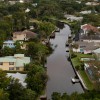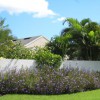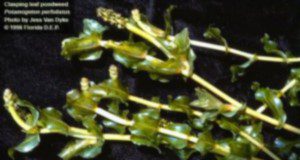This new 9-page factsheet describes the defining characteristics of the eleven pondweed species that are present in Florida. It serves as a pondweed identification guide for aquatic habitat managers, lake monitors, conservationists, and plant enthusiasts, and it gives some context on each species’ life history and ecological role. Written by Christine Rohal, Laura Reynolds, Carrie Reinhardt Adams, and Charles Martin, and published by the UF/IFAS Department of Soil and Water Sciences.
https://edis.ifas.ufl.edu/ss686
Tag: Carrie Reinhardt Adams
A Comparison of Planting Techniques for Submerged Aquatic Vegetation
Submerged aquatic vegetation has numerous benefits for aquatic ecosystems, from improving water quality to providing important habitat that supports a diverse food web. This new 6-page publication of the UF/IFAS Department of Soil and Water Sciences describes the breadth of options available to managers who wish to plant SAV at new locations. Because all methods have both benefits and drawbacks, and because all planting locations have different (often unknown) challenges for plant survival, managers may choose to try multiple methods to increase the likelihood for success. Written by Laura Reynolds, Carrie Reinhardt Adams, Enrique Latimer, Charles W. Martin, Christine Rohal, and Jodi Slater.
https://edis.ifas.ufl.edu/ss685
Ecosystem Services Valuation for Estuarine and Coastal Restoration in Florida
 Throughout Florida’s history, humans have altered the coastlines, leading to large-scale degradation of coastal ecosystems. This has led to the loss of associated ecosystem services, including products such as food and timber and processes like coastal protection and disease control. Unfortunately, ecosystem restoration efforts have not always been a priority for coastal management. This 10-page literature review surveys the available ecosystem-service valuation literature for five of Florida’s coastal natural communities–oyster reefs, beach dunes, mangrove forests, seagrass beds, and salt marshes–to facilitate the quantification of ecosystem services to provide a better measure of the full impact of restoration efforts. Written by Susanna Blair, Carrie Adams, Tom Ankersen, Maia McGuire, and David Kaplan, and published by the UF Department of Sea Grant, November 2014. (UF/IFAS photo by Tyler Jones)
Throughout Florida’s history, humans have altered the coastlines, leading to large-scale degradation of coastal ecosystems. This has led to the loss of associated ecosystem services, including products such as food and timber and processes like coastal protection and disease control. Unfortunately, ecosystem restoration efforts have not always been a priority for coastal management. This 10-page literature review surveys the available ecosystem-service valuation literature for five of Florida’s coastal natural communities–oyster reefs, beach dunes, mangrove forests, seagrass beds, and salt marshes–to facilitate the quantification of ecosystem services to provide a better measure of the full impact of restoration efforts. Written by Susanna Blair, Carrie Adams, Tom Ankersen, Maia McGuire, and David Kaplan, and published by the UF Department of Sea Grant, November 2014. (UF/IFAS photo by Tyler Jones)
http://edis.ifas.ufl.edu/sg134
Managing Mexican Petunia (Ruellia simplex C. Wright) in the Home Landscape
 Environmental tolerance, abundant seed production, and an ability to easily grow from plant stem sections have allowed Mexican petunia to spread into natural areas that border urban areas. The Florida Exotic Pest Plant Council lists Mexican petunia (wild-type and non-sterile cultivars) as a Category 1 invasive species, meaning that it is “altering native plant communities by displacing native species, changing community structures or ecological functions, or hybridizing with natives”. These potential changes to community structure and ecological function are of particular concern in Florida wetlands, where changes to plant communities have the potential to impact not just plant-animal interactions, but also overall hydrology on a whole watershed level. This 6-page fact sheet was written by C. A. Reinhardt Adams, C. Wiese, L.C. Lee, S.B. Wilson, A. M. Smith, and R. Freyre, and published by the UF Department of Environmental Horticulture, April 2014.
Environmental tolerance, abundant seed production, and an ability to easily grow from plant stem sections have allowed Mexican petunia to spread into natural areas that border urban areas. The Florida Exotic Pest Plant Council lists Mexican petunia (wild-type and non-sterile cultivars) as a Category 1 invasive species, meaning that it is “altering native plant communities by displacing native species, changing community structures or ecological functions, or hybridizing with natives”. These potential changes to community structure and ecological function are of particular concern in Florida wetlands, where changes to plant communities have the potential to impact not just plant-animal interactions, but also overall hydrology on a whole watershed level. This 6-page fact sheet was written by C. A. Reinhardt Adams, C. Wiese, L.C. Lee, S.B. Wilson, A. M. Smith, and R. Freyre, and published by the UF Department of Environmental Horticulture, April 2014.
http://edis.ifas.ufl.edu/ep498
ENH1161/EP423 Research Needs and Logistic Impediments in Restoration, Enhancement, and Management Projects: A Survey of Land Managers
ENH1161, a 7-page report by Carrie R. Adams and Nancy M. Steigerwalt, presents the results of a survey of practitioners and land managers to determine research and outreach needs for restoration, enhancement, and management goals in the southeastern coastal plain. Includes references. Published by the UF Department of Environmental Horticulture, March 2010.
http://edis.ifas.ufl.edu/ep423
ENH1104/EP368 Establishment of Leavenworth’s Tickseed (Coreopsis leavenworthii) on Roadside Right-of-Ways
ENH-1104, a 7-page illustrated fact sheet by Jeffrey G. Norcini, Anne L. Frances, Carrie Reinhardt Adams, provides recommendations for establishing this upright wildflower with showy yellow petals and brownish center that occurs almost exclusively in Florida, including ecotypes, site selection, site preparation, sowing seeds, establishment and maintenance. Includes references. Published by the UF Department of Environmental Horticulture, April 2009.
http://edis.ifas.ufl.edu/EP368
ENH1103/EP367 Establishment of Lanceleaf Tickseed (Coreopsis lanceolata) in Roadside Right-of-Ways
ENH-1103, an 8-page illustrated fact sheet by Jeffrey G. Norcini, Anne L. Frances, Carrie Reinhardt Adams, provides recommendations for establishing northern-Florida ecotypes of this low-growing, short-lived perennial that blooms with yellow flowers in early to mid-spring, including site selection, site preparation, sowing seeds, establishment and maintenance. Includes references. Published by the UF Department of Environmental Horticulture, March 2009.
http://edis.ifas.ufl.edu/EP367
ENH1090/EP354 Methodology for Wetland Seedbank Assays
ENH-1090, a 6-page illustrated fact sheet by Carrie Reinhardt Adams and Nancy M. Steigerwalt, summarizes standard techniques for wetland seed bank assays, including greenhouse set-up, sample collection and sample processing. Includes references. Published by the UF Department of Environmental Horticulture, February 2008.
http://edis.ifas.ufl.edu/EP354

